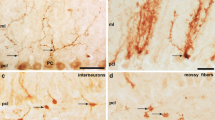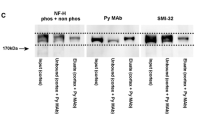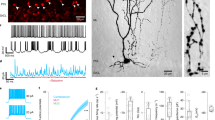Abstract
Despite the general uniformity in cellular composition of the adult cerebellum (Cb), the expression of proteins such as ZebrinII/AldolaseC and the small heat shock protein HSP25 reveal striking patterns of parasagittal Purkinje cell (PC) stripes. Based on differences in the stripe configuration within subsets of lobules, the Cb can be further divided into four anterior–posterior transverse zones: anterior zone (AZ) = lobules I–V, central zone (CZ) = lobules VI–VII, posterior zone (PZ) = lobules VIII and anterior IX, and the nodular zone (NZ) = lobules posterior IX–X. Here we used whole-mount and tissue section immunohistochemistry to show that neurofilament heavy chain (NFH) expression alone divides all lobules of the mouse Cb into a complex series of parasagittal stripes of PCs. We revealed that the striped pattern of NFH in the vermis of the AZ and PZ was complementary to ZebrinII and phospholipase C ß3 (PLCß3), and corresponded to phospholipase C ß4 (PLCß4). In the CZ and NZ the stripe pattern of NFH was complementary to HSP25 and corresponded to PLCß3. The boundaries of the NFH stripes were not always sharply delineated. Instead, a gradual decrease in NFH expression was observed toward the edges of particular stripes, resulting in domains comprised of overlapping expression patterns. Furthermore, the terminal field distributions of mossy and climbing fibers had a complex but consistent topographical alignment with NFH stripes. In summary, NFH expression reveals an exquisite level of Cb stripe complexity that respects the transverse zone divisions and delineates an intricately patterned target field for Cb afferents.








Similar content being viewed by others
References
Ahn AH, Dziennis S, Hawkes R, Herrup K (1994) The cloning of zebrin II reveals its identity with aldolase C. Development 120(8):2081–2090
Brochu G, Maler L, Hawkes R (1990) Zebrin II: a polypeptide antigen expressed selectively by Purkinje cells reveals compartments in rat and fish cerebellum. J Comp Neurol 291(4):538–552
Armstrong CL, Krueger-Naug AM, Currie RW, Hawkes R (2000) Constitutive expression of the 25-kDa heat shock protein Hsp25 reveals novel parasagittal bands of purkinje cells in the adult mouse cerebellar cortex. J Comp Neurol 416(3):383–397
Sarna JR, Marzban H, Watanabe M, Hawkes R (2006) Complementary stripes of phospholipase Cbeta3 and Cbeta4 expression by Purkinje cell subsets in the mouse cerebellum. J Comp Neurol 496(3):303–313
Armstrong CL, Hawkes R (2000) Pattern formation in the cerebellar cortex. Biochem Cell Biol 78(5):551–562
Larouche M, Hawkes R (2006) From clusters to stripes: the developmental origins of adult cerebellar compartmentation. Cerebellum 5(2):77–88
Sillitoe RV, Joyner AL (2007) Morphology, molecular codes, and circuitry produce the three-dimensional complexity of the cerebellum. Annu Rev Cell Dev Biol 23:549–577
Ozol K, Hayden JM, Oberdick J, Hawkes R (1999) Transverse zones in the vermis of the mouse cerebellum. J Comp Neurol 412(1):95–111
Gravel C, Hawkes R (1990) Parasagittal organization of the rat cerebellar cortex: direct comparison of Purkinje cell compartments and the organization of the spinocerebellar projection. J Comp Neurol 291(1):79–102
Akintunde A, Eisenman LM (1994) External cuneocerebellar projection and Purkinje cell zebrin II bands: a direct comparison of parasagittal banding in the mouse cerebellum. J Chem Neuroanat 7(1–2):75–86
Ji Z, Hawkes R (1994) Topography of Purkinje cell compartments and mossy fiber terminal fields in lobules II and III of the rat cerebellar cortex: spinocerebellar and cuneocerebellar projections. Neuroscience 61(4):935–954
Voogd J, Pardoe J, Ruigrok TJ, Apps R (2003) The distribution of climbing and mossy fiber collateral branches from the copula pyramidis and the paramedian lobule: congruence of climbing fiber cortical zones and the pattern of zebrin banding within the rat cerebellum. J Neurosci 23(11):4645–4656
Paradies MA, Grishkat H, Smeyne RJ, Oberdick J, Morgan JI, Eisenman LM (1996) Correspondence between L7-lacZ-expressing Purkinje cells and labeled olivocerebellar fibers during late embryogenesis in the mouse. J Comp Neurol 374(3):451–466
Wassef M, Cholley B, Heizmann CW, Sotelo C (1992) Development of the olivocerebellar projection in the rat: II. Matching of the developmental compartmentations of the cerebellum and inferior olive through the projection map. J Comp Neurol 323(4):537–550
Gravel C, Eisenman LM, Sasseville R, Hawkes R (1987) Parasagittal organization of the rat cerebellar cortex: direct correlation between antigenic Purkinje cell bands revealed by mabQ113 and the organization of the olivocerebellar projection. J Comp Neurol 265(2):294–310
Chockkan V, Hawkes R (1994) Functional and antigenic maps in the rat cerebellum: zebrin compartmentation and vibrissal receptive fields in lobule IXa. J Comp Neurol 345(1):33–45
Chen G, Hanson CL, Ebner TJ (1996) Functional parasagittal compartments in the rat cerebellar cortex: an in vivo optical imaging study using neutral red. J Neurophysiol 76(6):4169–4174
Hallem JS, Thompson JH, Gundappa-Sulur G, Hawkes R, Bjaalie JG, Bower JM (1999) Spatial correspondence between tactile projection patterns and the distribution of the antigenic Purkinje cell markers anti-zebrin I and anti-zebrin II in the cerebellar folium crus IIA of the rat. Neuroscience 93(3):1083–1094
Wadiche JI, Jahr CE (2005) Patterned expression of Purkinje cell glutamate transporters controls synaptic plasticity. Nat Neurosci 8(10):1329–1334
Perrot R, Berges R, Bocquet A, Eyer J (2008) Review of the multiple aspects of neurofilament functions, and their possible contribution to neurodegeneration. Mol Neurobiol 38(1):27–65
Lee MK, Cleveland DW (1996) Neuronal intermediate filaments. Annu Rev Neurosci 19:187–217
Angelides KJ, Smith KE, Takeda M (1989) Assembly and exchange of intermediate filament proteins of neurons: neurofilaments are dynamic structures. J Cell Biol 108(4):1495–1506
Julien JP, Meyer D, Flavell D, Hurst J, Grosveld F (1986) Cloning and developmental expression of the murine neurofilament gene family. Brain Res 387(3):243–250
Carden MJ, Trojanowski JQ, Schlaepfer WW, Lee VM (1987) Two-stage expression of neurofilament polypeptides during rat neurogenesis with early establishment of adult phosphorylation patterns. J Neurosci 7(11):3489–3504
Hoffman PN, Thompson GW, Griffin JW, Price DL (1985) Changes in neurofilament transport coincide temporally with alterations in the caliber of axons in regenerating motor fibers. J Cell Biol 101(4):1332–1340
Elder GA, Friedrich VL Jr, Kang C, Bosco P, Gourov A, Tu PH et al (1998) Requirement of heavy neurofilament subunit in the development of axons with large calibers. J Cell Biol 143(1):195–205
Julien JP, Mushynski WE (1983) The distribution of phosphorylation sites among identified proteolytic fragments of mammalian neurofilaments. J Biol Chem 258(6):4019–4025
Carden MJ, Schlaepfer WW, Lee VM (1985) The structure, biochemical properties, and immunogenicity of neurofilament peripheral regions are determined by phosphorylation state. J Biol Chem 260(17):9805–9817
Goldstein ME, Cooper HS, Bruce J, Carden MJ, Lee VM, Schlaepfer WW (1987) Phosphorylation of neurofilament proteins and chromatolysis following transection of rat sciatic nerve. J Neurosci 7(5):1586–1594
Shea TB, Chan WK (2008) Regulation of neurofilament dynamics by phosphorylation. Eur J NeuroSci 27(8):1893–1901
Wang S, Hamberger A, Yang Q, Haglid KG (1994) Changes in neurofilament protein NF-L and NF-H immunoreactivity following kainic acid-induced seizures. J Neurochem 62(2):739–748
Hashimoto R, Nakamura Y, Komai S, Kashiwagi Y, Tamura K, Goto T et al (2000) Site-specific phosphorylation of neurofilament-L is mediated by calcium/calmodulin-dependent protein kinase II in the apical dendrites during long-term potentiation. J Neurochem 75(1):373–382
Posmantur RM, Newcomb JK, Kampfl A, Hayes RL (2000) Light and confocal microscopic studies of evolutionary changes in neurofilament proteins following cortical impact injury in the rat. Exp Neurol 161(1):15–26
Lein ES, Hawrylycz MJ, Ao N, Ayres M, Bensinger A, Bernard A et al (2007) Genome-wide atlas of gene expression in the adult mouse brain. Nature 445(7124):168–176
Sillitoe RV, Stephen D, Lao Z, Joyner AL (2008) Engrailed homeobox genes determine the organization of Purkinje cell sagittal stripe gene expression in the adult cerebellum. J Neurosci 28(47):12150–12162
Sillitoe RV, Benson MA, Blake DJ, Hawkes R (2003) Abnormal dysbindin expression in cerebellar mossy fiber synapses in the mdx mouse model of Duchenne muscular dystrophy. J Neurosci 23(16):6576–6585
Sillitoe RV, Hawkes R (2002) Whole-mount immunohistochemistry: a high-throughput screen for patterning defects in the mouse cerebellum. J Histochem Cytochem 50(2):235–244
Langley OK, Sternberger NH, Sternberger LA (1988) Expression of neurofilament proteins by Purkinje cells: ultrastructural immunolocalization with monoclonal antibodies. Brain Res 457(1):12–20
Vega JA, Del Valle M, Amenta F (1994) Expression of neurofilament proteins in the rat cerebellar cortex as a function of age: an immunohistochemical study. Mech Ageing Dev 73(1):9–16
Marc C, Clavel MC, Rabie A (1986) Non-phosphorylated and phosphorylated neurofilaments in the cerebellum of the rat: an immunocytochemical study using monoclonal antibodies. Development in normal and thyroid-deficient animals. Brain Res 391(2):249–260
Ango F, di Cristo G, Higashiyama H, Bennett V, Wu P, Huang ZJ (2004) Ankyrin-based subcellular gradient of neurofascin, an immunoglobulin family protein, directs GABAergic innervation at purkinje axon initial segment. Cell 119(2):257–272
Eisenman LM, Hawkes R (1993) Antigenic compartmentation in the mouse cerebellar cortex: zebrin and HNK-1 reveal a complex, overlapping molecular topography. J Comp Neurol 335(4):586–605
Marzban H, Sillitoe RV, Hoy M, Chung SH, Rafuse VF, Hawkes R (2004) Abnormal HNK-1 expression in the cerebellum of an N-CAM null mouse. J Neurocytol 33(1):117–130
Schonewille M, Luo C, Ruigrok TJ, Voogd J, Schmolesky MT, Rutteman M et al (2006) Zonal organization of the mouse flocculus: physiology, input, and output. J Comp Neurol 497(4):670–682
Armstrong CL, Chung SH, Armstrong JN, Hochgeschwender U, Jeong YG, Hawkes R (2009) A novel somatostatin-immunoreactive mossy fiber pathway associated with HSP25-immunoreactive purkinje cell stripes in the mouse cerebellum. J Comp Neurol 517(4):524–538
Sugihara I, Shinoda Y (2004) Molecular, topographic, and functional organization of the cerebellar cortex: a study with combined aldolase C and olivocerebellar labeling. J Neurosci 24(40):8771–8785
Sugihara I, Quy PN (2007) Identification of aldolase C compartments in the mouse cerebellar cortex by olivocerebellar labeling. J Comp Neurol 500(6):1076–1092
Sawada K, Fukui Y, Hawkes R (2008) Spatial distribution of corticotropin-releasing factor immunopositive climbing fibers in the mouse cerebellum: analysis by whole mount immunohistochemistry. Brain Res 1222:106–117
Goldowitz D, Hamre K (1998) The cells and molecules that make a cerebellum. Trends Neurosci 21(9):375–382
Voogd J, Glickstein M (1998) The anatomy of the cerebellum. Trends Neurosci 21(9):370–375
Ebner TJ, Chen G, Gao W, Reinert K (2005) Optical imaging of cerebellar functional architectures: parallel fiber beams, parasagittal bands and spreading acidification. Prog Brain Res 148:125–138
Sillitoe RV, Marzban H, Larouche M, Zahedi S, Affanni J, Hawkes R (2005) Conservation of the architecture of the anterior lobe vermis of the cerebellum across mammalian species. Prog Brain Res 148:283–297
Leclerc N, Schwarting GA, Herrup K, Hawkes R, Yamamoto M (1992) Compartmentation in mammalian cerebellum: Zebrin II and P-path antibodies define three classes of sagittally organized bands of Purkinje cells. Proc Natl Acad Sci U S A 89(11):5006–5010
Plioplys AV, Thibault J, Hawkes R (1985) Selective staining of a subset of Purkinje cells in the human cerebellum with monoclonal antibody mabQ113. J Neurol Sci 70(3):245–256
Sillitoe RV, Malz CR, Rockland K, Hawkes R (2004) Antigenic compartmentation of the primate and tree shrew cerebellum: a common topography of zebrin II in Macaca mulatta and Tupaia belangeri. J Anat 204(4):257–269
Sillitoe RV, Kunzle H, Hawkes R (2003) Zebrin II compartmentation of the cerebellum in a basal insectivore, the Madagascan hedgehog tenrec Echinops telfairi. J Anat 203(3):283–296
Milosevic A, Zecevic N (1998) Developmental changes in human cerebellum: expression of intracellular calcium receptors, calcium-binding proteins, and phosphorylated and nonphosphorylated neurofilament protein. J Comp Neurol 396(4):442–460
Ashwell KW, Paxinos G, Watson CR (2007) Cyto- and chemoarchitecture of the cerebellum of the short-beaked echidna (Tachyglossus aculeatus). Brain Behav Evol 70(2):71–89
Sillitoe RV, Gopal N, Joyner AL (2009) Embryonic origins of ZebrinII parasagittal stripes and establishment of topographic Purkinje cell projections. Neuroscience 162(3):574–588
Marzban H, Chung S, Watanabe M, Hawkes R (2007) Phospholipase Cbeta4 expression reveals the continuity of cerebellar topography through development. J Comp Neurol 502(5):857–871
Marzban H, Kim CT, Doorn D, Chung SH, Hawkes R (2008) A novel transverse expression domain in the mouse cerebellum revealed by a neurofilament-associated antigen. Neuroscience 153(4):1190–1201
Sillitoe RV, Hulliger M, Dyck R, Hawkes R (2003) Antigenic compartmentation of the cat cerebellar cortex. Brain Res 977(1):1–15
Hisano S, Sawada K, Kawano M, Kanemoto M, Xiong G, Mogi K et al (2002) Expression of inorganic phosphate/vesicular glutamate transporters (BNPI/VGLUT1 and DNPI/VGLUT2) in the cerebellum and precerebellar nuclei of the rat. Brain Res Mol Brain Res 107(1):23–31
Hioki H, Fujiyama F, Taki K, Tomioka R, Furuta T, Tamamaki N et al (2003) Differential distribution of vesicular glutamate transporters in the rat cerebellar cortex. Neuroscience 117(1):1–6
Acknowledgments
We thank Dr. Richard Hawkes for critically reading the manuscript and Dr. Alexandra Joyner for advice and research support. RVS is supported by new investigator start-up funds from Albert Einstein College of Medicine of Yeshiva University.
Author information
Authors and Affiliations
Corresponding author
Additional information
Adrien Demilly and Stacey L. Reeber contributed equally to this study.
Rights and permissions
About this article
Cite this article
Demilly, A., Reeber, S.L., Gebre, S.A. et al. Neurofilament Heavy Chain Expression Reveals a Unique Parasagittal Stripe Topography in the Mouse Cerebellum. Cerebellum 10, 409–421 (2011). https://doi.org/10.1007/s12311-010-0156-y
Published:
Issue Date:
DOI: https://doi.org/10.1007/s12311-010-0156-y




